Antique Clocks
-
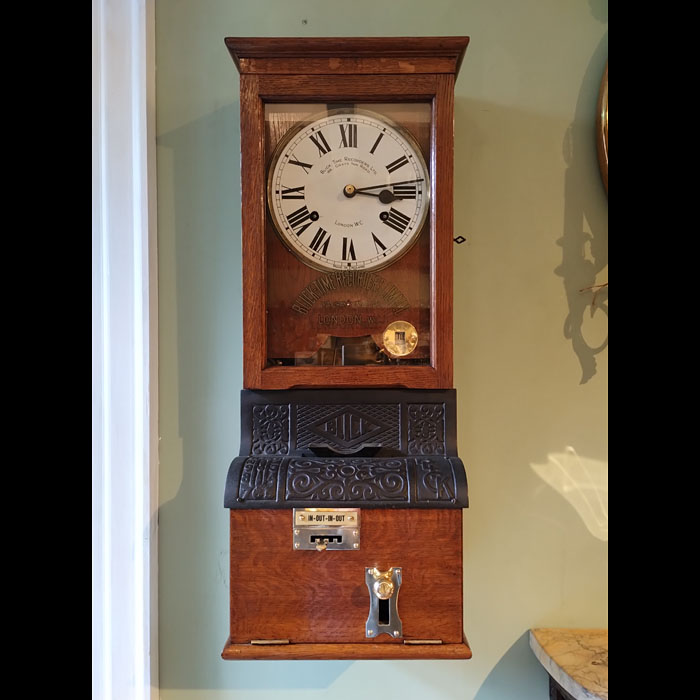
Stock: 16590
A fine example of an early twentieth century oak cased time recorder clock, with an eight day movement. The glass to the door bears the words Blick-Time Recorders Limited 174 Gray's Inn Road London SE1. The clock face with Roman numerals is set within a wooden frame and bears the name "Blick Time Recorder Ltd. 188 Grays Inn Road, London EC". The ornate cast iron front containing the card slot is also inscribed with the Blick name in a diamond lozenge This Time Recorder clock is fully serviced and in full working order, with its original keys.
English, circa 1930.
Notes: Time Recorders like this one would have been used to record the times workers came in and out of their place of work. Blick was started around 1900. In 1917 the company bought the sales rights for the Follet time stamp (USA). Blick was one of the two largest manufacturers of time recorders in the UK. In 1920 the National Time Recorder Company agreed to market their machines as 'Blick National' in the UK. In 1922 the company 'Blick Time Recorders Ltd' was established and in 1927 the word 'National' was was dropped and all machines being sold under the Blick name.
View our collection of: Antique clocks and clock garniture
|
Width |
Height |
Depth |
|
14"
35.5 cms |
34 1⁄4"
87.2 cms |
11"
28 cms |
|
|
|
|
Listed Price: £960 (+VAT where applicable)
More info?

-
Stock: 16526
A small German fruit wood, faux bamboo Aesthetic movement mantle clock of Architectural Form. The gilt, blue and black painted face with Roman numerals surrounding the floral centre, is flanked by stylised foliate spandrels. The pretty faux bamboo case has a lovely warm colour and patina. The 14 Day movement by H.A.C, (standing for, Hamburg American Clock Co) which was founded in 1887, was manufactured in Wurttemberg.
German, circa 1895.
View our collection of: Antique clocks and clock garniture
A large Victorian Gothic walnut cased bracket clock
|
Width |
Height |
Depth |
|
8 1⁄4"
21 cms |
12 13⁄16"
32.4 cms |
5 1⁄4"
13.5 cms |
|
|
|
|
Listed Price: £420 (+VAT where applicable)
More info?

-
Stock: 15769
A George the II Japanned longcase clock by James Jorden.
The brass eight day, five pillar movement, with an anchor escapement strikes on a single bell. The twelve inch brass arched top dial with Roman and Arabic numerals, with a matted centre engraved is with a basket of flowers and birds, with a subsidiary seconds dial and date aperture and signed 'Iam Iorden, Chatham', with gilt putti and crown spandrels, in the arch is an engraved boss of a bird. The case is in its original 18th century black and green lacquer, decorated with chinoiserie scenes, with gilt highlights.
English, circa 1750.
View our collection of: Antique clocks and clock garniture
A large Victorian Gothic walnut cased bracket clock
|
Width |
Height |
Depth |
|
19 1⁄4"
49 cms |
89"
226 cms |
9 1⁄4"
23.5 cms |
|
|
|
|
Listed Price: £4,600 (+VAT where applicable)
More info?

-
Stock: 16254
A fine ormolu mantel clock signed by Dieudonné Kinable (1794 – 1830). The 8 day movement with silk suspension strikes the hours and half hours on a single bell.
Kinable was one of the foremost clockmakers in 18th century Paris, and his studio was located at the salubrious Palais Royal.
This figural mantel clock embodies the Empire style and depicts the mythical figure of Orpheus, who was attributed with having the gift of music. He was the son of Apollo and the muse Calliope, and is depicted here playing the lyre. Resting against the side of the clock is also a bouzouki, a Greek instrument and a torch and laurel wreath rest nearby. The plinth is adorned with applied medallions of a musical theme and stands on bun feet.
French, c.1805.
View our collection of: Antique clocks and clock garniture
A large Victorian Gothic walnut cased bracket clock
|
Width |
Height |
Depth |
|
19 11⁄16"
50 cms |
10 3⁄16"
26 cms |
|
|
|
|
|
Listed Price: £3,800 (+VAT where applicable)
More info?

-
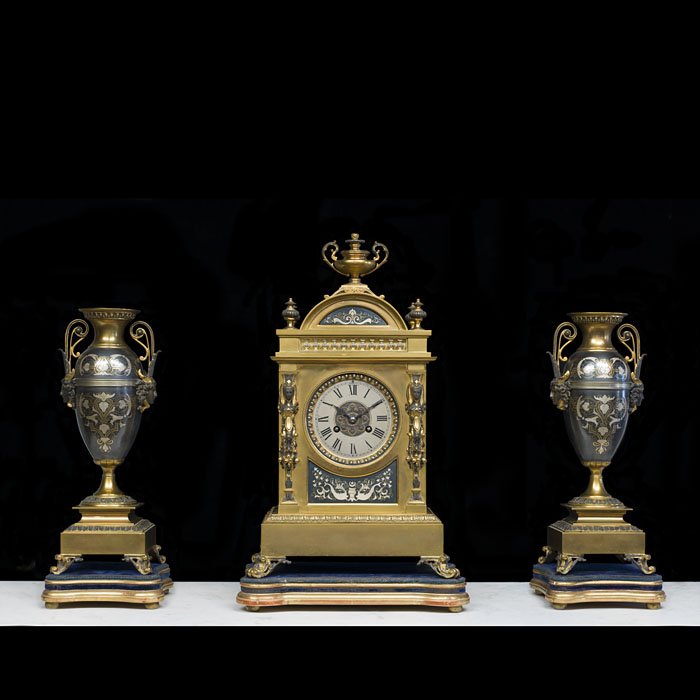
Stock: 14665
A gilt brass and bronze patinated clock garniture, with original gilt wood and royal blue velvet bases. The gilded case has decorative silvered, gilded and patinated panels. This matches the technique on the garniture, and this decoration is flanked by scrolling handles adorned with gorgons.
The movement by the renowned Parisian clock designer and maker, Louis Achille Brocot, strikes the hours and half hours on a single gong. Louis Achille Brocot was responsible for a great number of design innovations in French clock making during the mid 19th century.
French, circa 1870.
Louis Achille Brocot was born to a renowned clockmaking family in 1817. He went on to become an awarding winning clockmaker and mathematician. He invented the Brocot suspension which allowed the length of the pendulum to be altered, adjusting the time by turning a key on the dial. He died in 1878.
View our collection of: Antique clocks and clock garniture
A large Victorian Gothic walnut cased bracket clock
|
width |
height |
depth |
| Clock |
11 13⁄16"
30 cms |
19 1⁄4"
49 cms |
7 1⁄2"
19 cms |
| Vases |
6 1⁄4"
16 cms |
15 3⁄8"
39 cms |
|
Listed Price: £7,500 (+VAT where applicable)
More info?

-
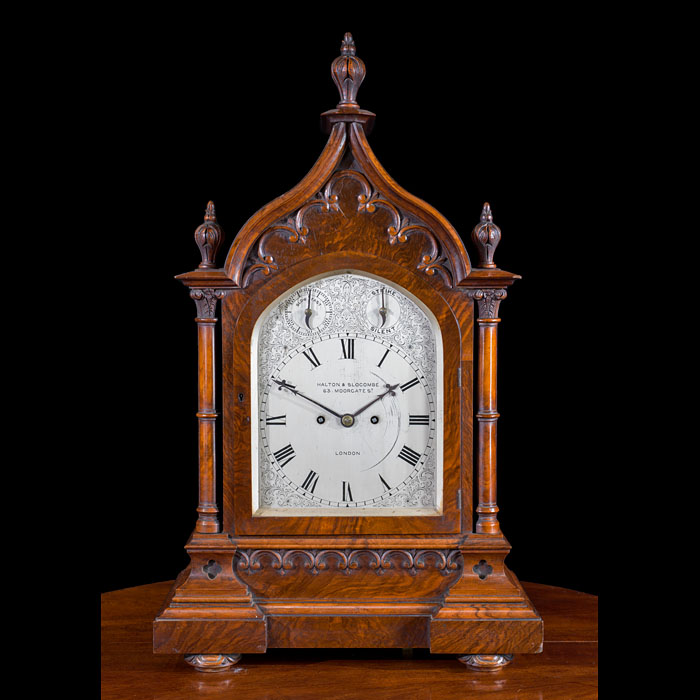
Stock: 15850
A very fine and large mid nineteenth-century Gothic Revival bracket clock in richly figured walnut, with a silvered dial.
The clock has a good quality English eight day, twin fusee, four pillar movement with anchor escapement, which strikes the hours on a single gong.
The profusely engraved silvered arched dial with Roman numerals has two subsidiary dials, namely; strike or silent and slow or fast. The chapter ring, signed by the London jewellers Halton & Slocombe, 63 Moorgate St, London, (probably the retailer rather than the maker) is framed by finely engraved spandrels.
The walnut case which retains its original colour and polish, is the perfect embodiment of the Gothic Revival. The case is topped with carved finials and supported by a pair or columns with acanthus leaf capitals, all set upon a heavily moulded plinth on carved bun feet, whilst the dial is framed by a simple arched glazed door.
English, circa 1815.
Note, the original silvering on the dial has in the past suffered some scratching from the hour had. The dial can be re-silvered if desired, at no extra cost.
View our collection of: Antique clocks and clock garniture
A large Victorian Gothic walnut cased bracket clock
|
Width |
Height |
Depth |
|
17 1⁄8"
43.5 cms |
27 3⁄8"
69.5 cms |
10 3⁄16"
26 cms |
|
|
|
|
Listed Price: £5,800 (+VAT where applicable)
More info?

-
Stock: 15752
A fine Georgian walnut bracket clock by John Greaves of Newcastle (born c.1725 and active between 1745-94) with an eight day five pillar twin train fusee movement and anchor escapement. The clockface has a beautifully silvered chapter ring and subsidiary dial, the former engraved with both Roman and Arabic numbers, the latter illustrating the strike silent mechanism. These are framed by ornate gilt brass spandrels. The clock has a beautifully engraved brass backplate with scrolling foliate decoration, which is a mark of quality and attention to detail. It strikes the hour on a single bell. With restorations.
English, c.1760.
View our collection of: Antique clocks and clock garniture
|
Width |
Height |
Depth |
|
10 3⁄16"
26 cms |
17 7⁄8"
45.5 cms |
7 1⁄2"
19 cms |
|
|
|
|
Listed Price: £6,200 (+VAT where applicable)
More info?

-
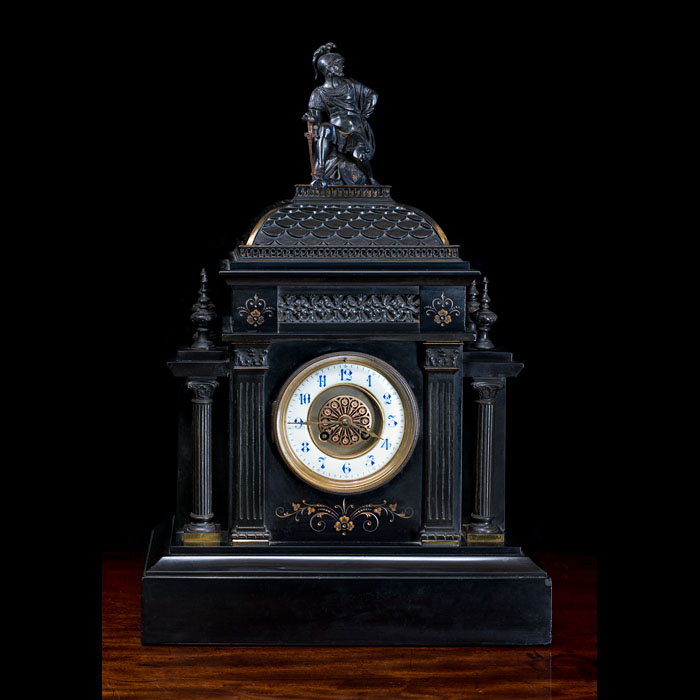 Sold
Sold
Stock: 15758
A large and imposing Victorian Belgian black marble and bronze mantel clock of architectural form. The case is surmounted by a bronze figure of a Roman Centurion who sits on a roof of fishscale tiles. The rest of the case is carved from Belgian black marble and is modelled as an architectural facade, with both corinthian pilasters and columns framing the dial. Behind the glass door, the dial is enameled with blue Arabic numerals. Inside, there is a fine eight day French movement that strikes the hours and the half-hour hours on a single gong.
English, c.1880.
View our collection of: Antique clocks and clock garniture
|
Width |
Height |
Depth |
|
14 3⁄8"
36.5 cms |
21 11⁄16"
55 cms |
6 11⁄16"
17 cms |
|
|
|
|
-
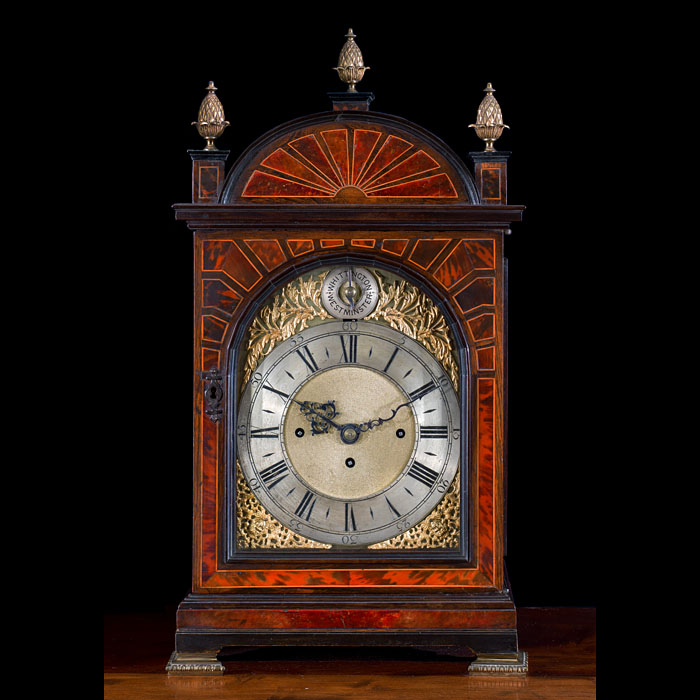
Stock: 15781
A very large and fine nineteenth-century rosewood and tortoiseshell bracket clock. The beautifully figured rosewood case is bordered with ebonised mouldings, inlaid with tortoiseshell and banded with boxwood. The arched pediment is surmounted by three gilded pineapple finials,
The clock has an extremely good, eight day triple fuseé four pillar movement with anchor escapement, it chimes the quarters either, "Whittington" on eight bells or "Westminster chimes" on four gongs and it strikes the hours on a single large gong. The movement is in beautiful original condition retaining its original brushed brass finish with all steel parts bright polished, while the five gongs are blued steel, all of which is visible through the large side and rear windows of the case. The movement is intended to be viewed through these windows and the quality reflects this intention.
The arched face has an engraved silvered brass chapter ring with matte gilt centre and Roman numerals, it also has a subsidiary dial above for selecting either Westminster or Whittington chimes. Under this there is a small level to silence the chimes. This dial is set amongst gilt brass foliate spandrels within the arch of the door and spandrels centred by female masks to the bottom.
There is a second smaller subsidiary dial above the clock face to adjust for fast/slow running, which is only visible when the main door is open.
English, circa 1880.
View our collection of: Antique clocks and clock garniture
|
Width |
Height |
Depth |
|
14 3⁄16"
36 cms |
26 1⁄8"
66.2 cms |
9 13⁄16"
24.8 cms |
|
|
|
|
Listed Price: £7,400 (+VAT where applicable)
More info?

-
Stock: 15773
A fine 18th century eight day bracket or table clock by Thomas Coxworthy, with a brass bound flame mahogany veneered case and silvered dial. The arched silvered dial has both Roman and Arabic numerals, which at its centre has the smaller calendar dial, and above, a strike/silent dial.
The eight day movement has a verge escapement - a feature of early clocks - and also strikes the hour on a bell. The brass backplate of the movement is beautifully engraved with foliate decoration, a mark of quality and attention to detail.
By Thomas Coxworthy of Plymouth of whom little is known aside from the fact his workshop was based at Plymouth Dock. English, c.1770.
Provenance: Dean's Farmhouse, Stratford-sub-Castle, Salisbury.
View our collection of: Antique clocks and clock garniture
|
Width |
Height |
|
|
11"
28 cms |
15 11⁄16"
40 cms |
|
|
|
|
|
Listed Price: £5,800 (+VAT where applicable)
More info?

-
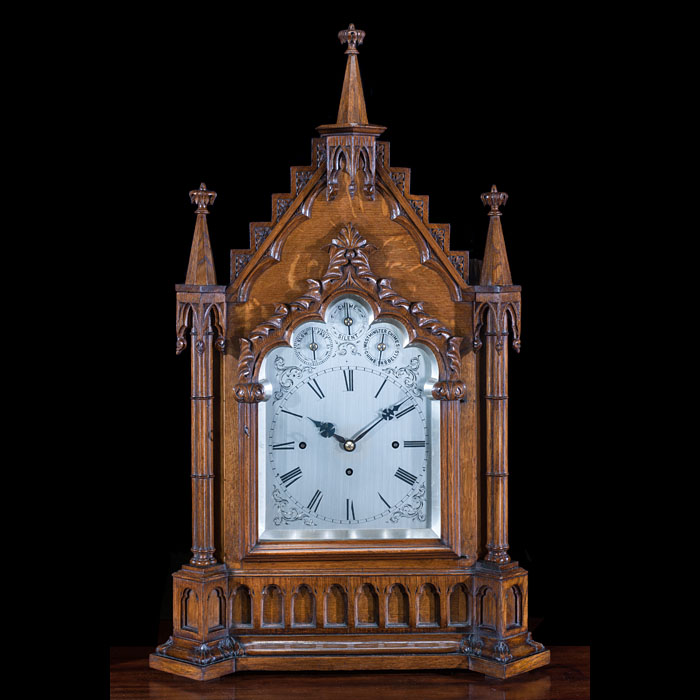 Sold
Sold
Stock: 15572
A fine and large nineteenth-century Gothic Revival oak bracket clock, with a silvered dial.
The clock has an eight day, triple fusee, four pillar movement with anchor escapement and chimes the quarters on either eight or four bells, "Westminster chimes" and strikes the hours on a single gong.
The finely engraved silvered arched top brass dial with Roman numerals has three subsidiary dials, namely; strike or silent, slow or fast, Westminster chime, or chime on 8 bells. Engraved spandrels frame the chapter ring.
The case is the perfect incarnation of the Gothic Revival, the cathedral case topped with spires and finials which are supported by cluster pilasters whilst the dial is framed with a foliate ogee window.
English, circa 1850.
View our collection of: Antique clocks and clock garniture
|
Width |
Height |
Depth |
|
16 1⁄2"
42 cms |
26"
66 cms |
9 3⁄8"
24 cms |
|
|
|
|
-
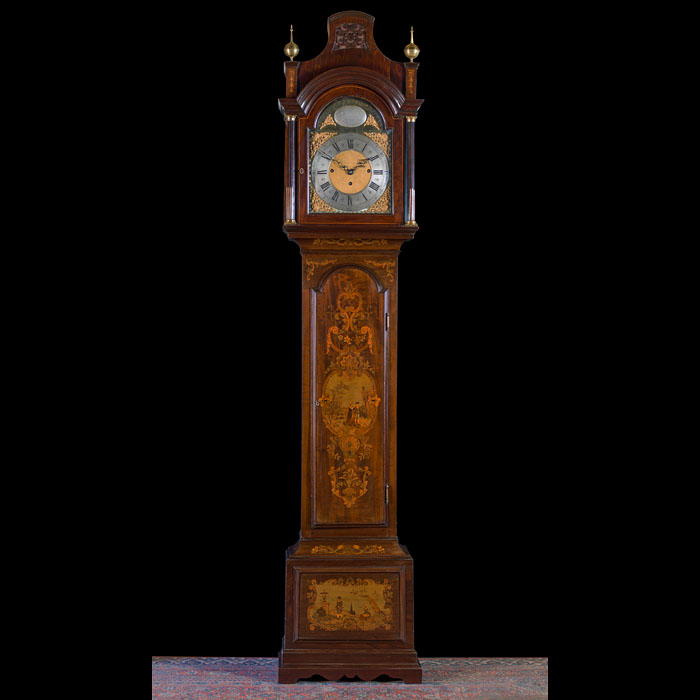 Sold
Sold
Stock: 15517
A fine mid-nineteenth century eight-day longcase clock by W.J. Frodsham of Change Alley, London within a mahogany and marquetry case.
The eight day, triple train, four pillar movement with anchor escapement, chimes the quarters on either eight or four bells, "Westminster chimes" and strikes the hours on a single gong. The 12 inch arched top brass dial with strike / silent lever and four bell chime / eight bell chime lever, has a silvered chapter ring with gilt brass putti and crown spandrels, beneath an oval cartouche engraved with the maker, W.J.Frodsham, Change Alley, London.
The fine marquetry - almost Rococo in design - depicts two lovers walking within a pastoral scene, and is framed by foliate scrolls and floral sprays.
English, circa 1840.
Notes:
The first recorded clockmaker by the name Frodsham was a William Frodsham, born in 1728 and is believed to have worked as a Journeyman for Justin Vulliamy, who was clockmaker to George III.
In the early 19th century, the family were established as clockmakers, and entered a partnership with the well-regarded chronometer makers, the Parkinson’s and the business became Parkinson & Frodsham of 4 Change Alley. After the death of William Parkinson, the firm became W J Frodsham’s in 1842, until he handed the business over to his sons in 1847 the year that those sons were admitted to the Clockmakers’ Company. In subsequent years, the Frodshams exhibited at the Paris Exhibition of 1867 and 1889, developing and international reputation for quality.
Condition notes: A very slight warp to the bottom of the trunk door.
|
width |
height |
depth |
|
20 1⁄2"
52 cms |
95 1⁄2"
242.5 cms |
10 5⁄8"
27 cms |
|
|
|
|
-
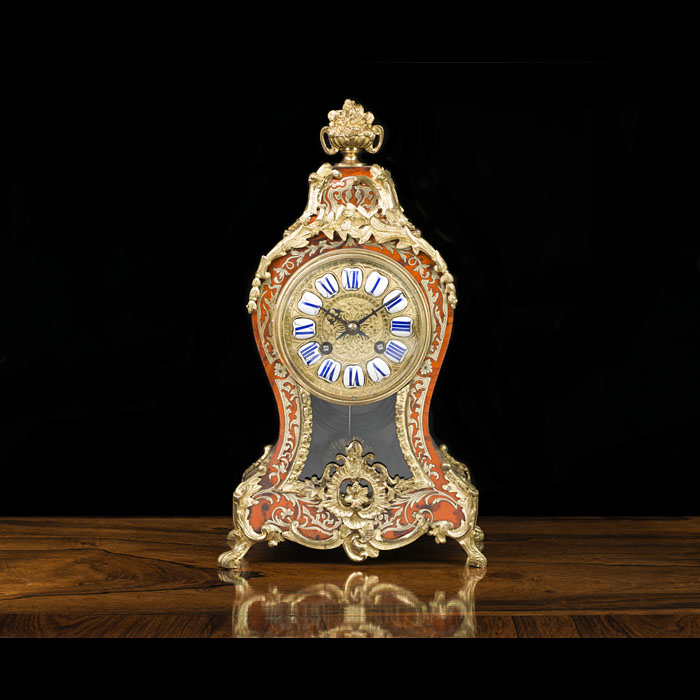 Sold
Sold
Stock: 15753
A fine 19th century French boulle red tortoiseshell mantel clock with brass boulle inlay in the Rococo style. The ormolu case mounts are surmounted by an urn finial and the ormolu dial is mounted with enamel numerals and blued steel hands. The movement is a two trained striking movement and is stamped A&N.
French, late 19th century.
Notes:
Boulle work is an inlay process that was developed by the French Cabinet maker to the crown, André Charles Boulle (1642-1732). It involves veneering objects with tortoiseshell and inlaying this surface with gilt brass, brass or pewter in elaborate designs.
View our collection of: Antique clocks and clock garniture
|
Width |
Height |
Depth |
|
7 1⁄2"
19 cms |
13"
33 cms |
4 1⁄4"
11 cms |
|
|
|
|
-
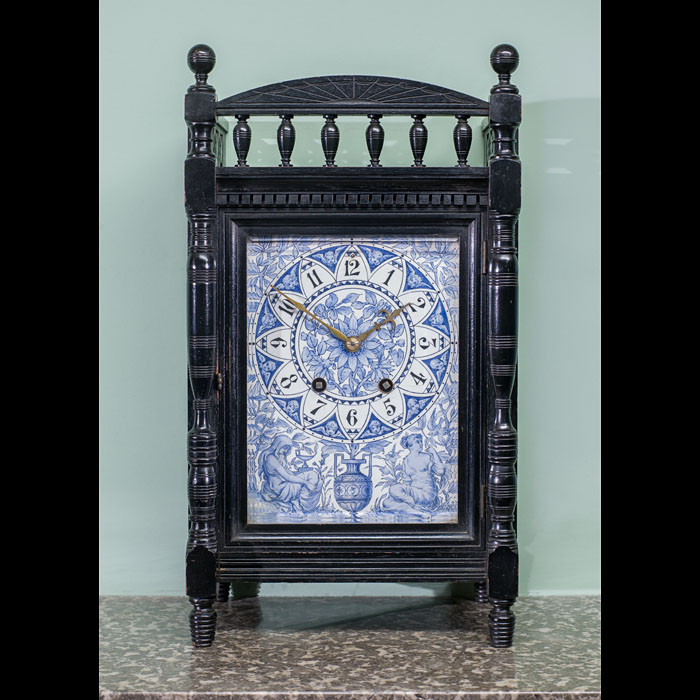
Stock: 15626
A magnificent Aesthetic Movement mantel clock, with an ebonised mahogany case and an exquisitely painted dial. The case embodies the style of the Aesthetic Movement , with an arched and turned gallery, surmounted by two turned ball finials, with a dentil moulding below. Supporting the finials are two turned spindle pilasters framing the dial.
The blue and white hand-painted and glazed porcelain dial depicts allegories of night and day within a floral and foliate design, Night appearing as a women in sleep with a bat flying above her, and Day, gazing up at a swift as it swoops past. The chapter ring takes the form of a sunflower, each petal frames a number. The simple brass hands are fixed within the centre of another sunflower. The movement is a twin-train eight day movement, strikes on the hour and half hour and runs well.
Attributed to Lewis Foreman Day for the retailers, Howell, James & Co of Regent Street, London.
|
Width |
Height |
Depth |
|
10 3⁄8"
26.5 cms |
19 1⁄8"
48.5 cms |
7 1⁄4"
18.5 cms |
|
|
|
|
Listed Price: £3,800 (+VAT where applicable)
More info?

-
Stock: 15458
An Elegant 30 hour Georgian longcase clock with an arched hood and small wooden ball finials. The arch of the hood is decorated with blind fretwork which frames the lunette engraved to denote the maker. The lunette and the rest of the brass dial is adorned by Baroque spandrels, which frame a chapter ring with engraved Roman and Arabic numerals, and at the centre of the dial is a subsidiary seconds dial and a date window. The glazed door is flanked by two plain columns, and this is echoed by the plain pilasters on the trunk. By Thomas Clark of Warrington.
English, early 18th century.
View our collection of: Antique clocks and clock garniture
|
width |
height |
depth |
|
20 1⁄2"
52 cms |
86 3⁄16"
219 cms |
11"
28 cms |
|
|
|
|
Listed Price: £3,200 (+VAT where applicable)
More info?

-
Stock: 15560
A late 18th century, mahogany longcase clock by Joseph Grey of Durham. The case is enriched with satinwood crossbanding, bordered by ebony and box wood stringing. The moulded, inlaid trunk door is flanked by a pair of reeded quarter pilasters over the the generously moulded plinth, on ogeed feet.
The brass arched top dial with gilt pierced spandrels, silvered chapter ring with Roman hours and Arabic minutes has a matt centre with a subsidiary seconds dial and date aperture. This is flanked by a pair of reeded columns with brass Corinthian capitals, beneath a swan-neck pediment with brass finals and central brass eagle. The four pillar eight day movement strikes the hours on a single bronze bell.
English, circa 1760.
View our collection of: Antique clocks and clock garniture
|
|
Height |
Width |
|
|
90 3⁄16"
229 cms |
10 5⁄8"
27 cms |
|
|
|
|
Listed Price: £3,200 (+VAT where applicable)
More info?

-
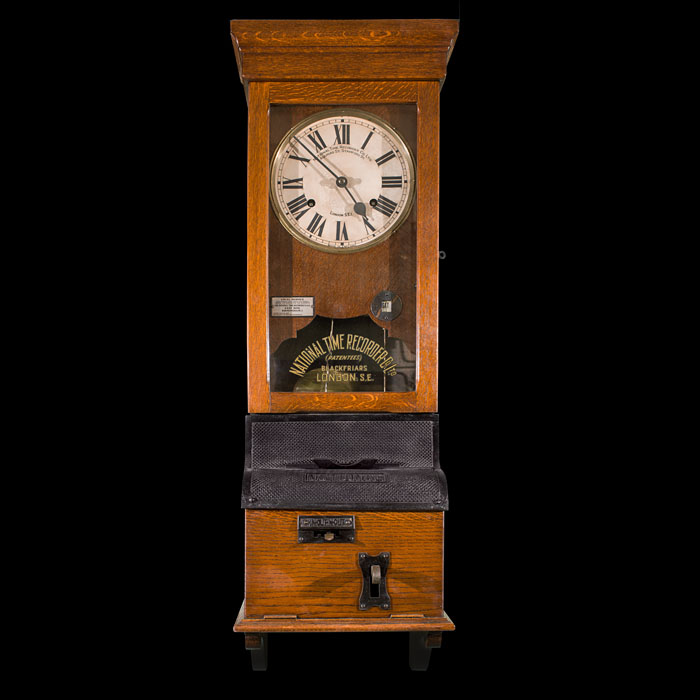 Sold
Sold
Stock: 15508
A good example of an early twentieth century time recorder clock in an oak case, serial number 51947. The glass door panel bears the words, "National Time Recorder Co. (Patentees) Blackfriars London. S.E.". The clock face with Roman numerals is set within a wood frame and bears the name "National Time Recorder Co. Ltd. Aquinas St, Stamford St. London EC1". beneath which is a small metal plaque stating "Local service, The National Time Recorder Co Ltd. Phone: Central 3655 . This Time Recorder is in full working order.
English, circa 1935.
Notes: Time Recorders like this one would have been used to record the times workers came in and out of their place of work. The National Time Recorder Co. Ltd (incorporated in 1917, company number 146424, though possibly founded around 10 years earlier in 1907) was one of the two largest UK manufacturers of time recorders. The head office and factory was originally based in Blackfriars London, and moved to the Lagoon Works in St Mary Cray (Orpington) Kent in 1951, on the site of the Blue Lagoon swimming pool which had been damaged during the war. Other branches were established in London, Birmingham, Bristol, Dublin, Glasgow, Leeds, Manchester, Newcastle-upon-Tyne and Sheffield. [Source: World Clocks]
|
Width |
Height |
Depth |
|
12 1⁄2"
31.8 cms |
42"
106.7 cms |
11"
28 cms |
|
|
|
|
-
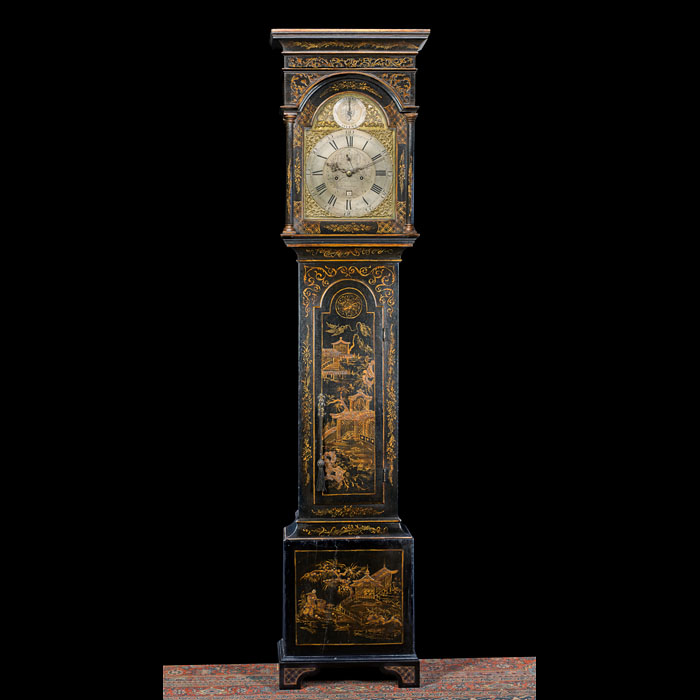 Sold
Sold
Stock: 15459
A fine oak longcase clock by Philip Avenell of Farnham with later lacquered chinoiserie decoration. The eight day movement strikes the hours on a clear bell. The clock face has a 12 inch brass break arched brass dial flanked by ornate gilt brass spandrels. The raised silvered chapter ring is crisply engraved with black Roman numerals and Arabic five minute numerals to the outer aspect. The central dial has a subsidiary seconds dial, a date aperture and is profusely engraved with floral decoration. The maker's signature is signed within a cartouche. The chinoiserie decoration was likely added in the early twentieth-century. English, c.1780
Notes: Philip Avenell was part of a 200 year dynasty of clockmakers based in the South of England. Watchmakers and clockmakers of the world’ by Brian Loomes records Phillip Avenell as working in London circa 1765 then in Farnham from circa 1775, roughly when this clock was made. Philip Avenell died in 1809.
|
Width |
Height |
Depth |
|
18 1⁄4"
46.5 cms |
86 5⁄8"
220 cms |
10"
25.5 cms |
|
|
|
|
-
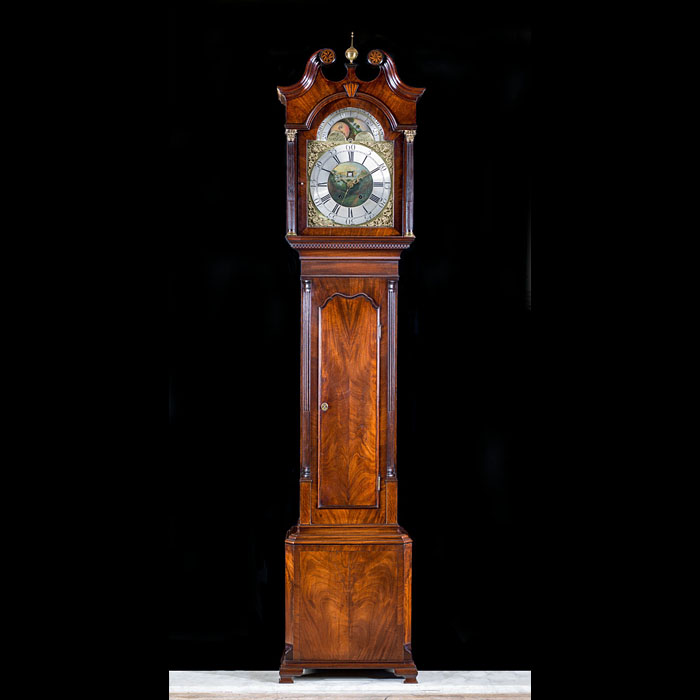 Sold
Sold
Stock: 15456
A very fine mahogany longcase clock, with an eight day movement by John Wyld of Nottingham. The fine silver dial is centred by a painted scene of a wooded landscape and this frames a date aperture. The lunette above is adorned with not only a painted moondial, but with opposing hemispheres. The dial is framed by very fine brass cherub spandrels, and mounted with three pierced hands.
The hood of the clock has a swan necked pediment with trompe l'oeil marquetry and a brass finial, which is echoes in the pair of fluted corinthian columns with brass capitals.
Inside the figured case is a four pillar movement which will be fully serviced on purchase.
Notes on the maker: John Wyld was an important and very competent maker who was born in Codnor, Derbyshire in 1710, son of another John Wyld (1678-1760) by Rebecca, sister of the notable Codnor clockmaker James Woolley (1695-1785), to whom Wyld was apprenticed. He set up at Codnor around 1732 and also rented a workshop in Chapel Bar in Nottingham from a Mr. Lupton shortly afterwards. He married in 1740 and died in 1773 leaving John, his successor at Nottingham, Joseph and three daughters.
Link to: Antique clocks and clock garniture
|
width |
height |
depth |
|
21 11⁄16"
55 cms |
96 7⁄8"
246 cms |
10 5⁄8"
27 cms |
|
|
|
|
-
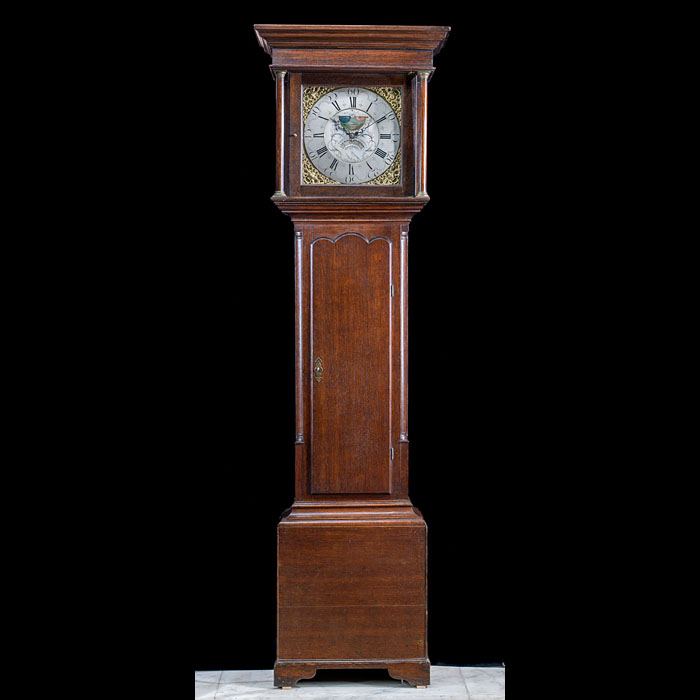 Sold
Sold
Stock: 15460
A George III 30 hour oak longcase clock with an engraved silvered dial and Roman numerals, framed by gilt spandrels to the corners. To the centre of the dial is a date aperture, and also an arched moondial with hand painted decoration. This elegant dial sits within a columned hood of an elegantly simple design. It has a 4 pillar movement. This clock will be serviced upon purchase.
Signed: Samuel Butterworth of Rochdale.
English, c.1770.
|
width |
height |
depth |
|
79"
200.6 cms |
23"
58.4 cms |
|
|
|
|
|
-
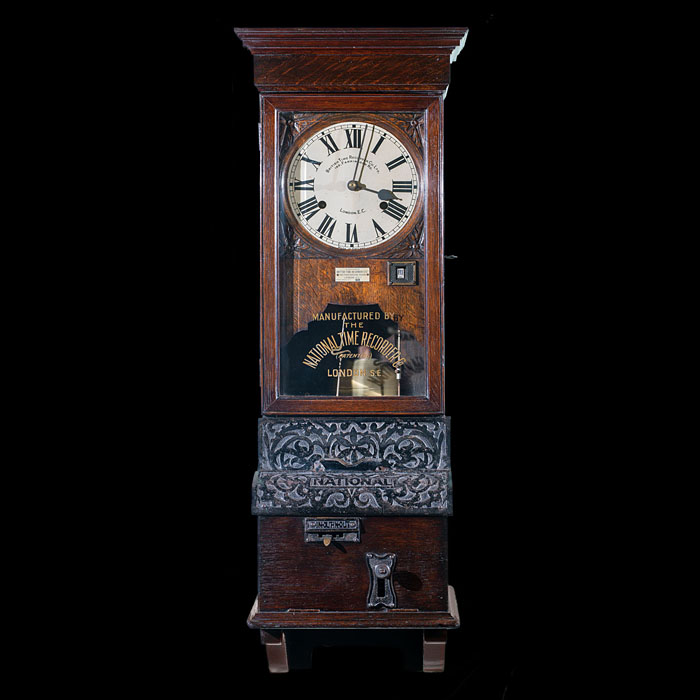 Sold
Sold
Stock: 15452
A fine example of an early twentieth century time recorder clock in an oak case. The bevelled glass panel bears the words 'Manufactured By The National Time Recorder Co. (Patentees) London SE.' The clock face with Roman numerals is set within a carved wood frame and bears the name British Time Recorder Co. Ltd. 149 Farringdon Road, London EC. beneath which is a small metal plaque stating 'Overhauled by British Time Recorder Co. Ltd, 149 Farringdon Road, London EC1 Phone. Terminus 1451 and the Reg No 8129'. This Time Recorder is in full working order.
English, circa 1912.
Notes: Time Recorders like this one would have been used to record the times workers came in and out of their place of work. The National Time Recorder Co. Ltd (incorporated in 1917, company number 146424, though possibly founded around 10 years earlier in 1907) was one of the two largest UK manufacturers of time recorders in the UK. The head office and factory was originally based in Blackfriars London, and moved to the Lagoon Works in St Mary Cray (Orpington) Kent in 1951, on the site of the Blue Lagoon swimming pool which had been damaged during the war. Other branches were established in London, Birmingham, Bristol, Dublin, Glasgow, Leeds, Manchester, Newcastle-upon-Tyne and Sheffield.
.
|
Width |
Height |
Depth |
|
15 7⁄8"
40.3 cms |
47"
119.5 cms |
11"
28 cms |
|
|
|
|
-
Stock: 14971
A large grand gilt bronze clock garniture in the Louis XVI style. The clock, with an 8 day striking movement that strikes on the half and the full hour and with it's original pendulum and key, is set in an ornate gilt bronze case mounted on its original giltwood base, which is a rare survival. The convex porcelain dial with cobalt blue Roman hours and black Arabic minutes, fine gilt hands, ringed lion masks and a bevelled convex glass door is topped by an ornate lidded urn with an acorn finial. The pair of tall five branch candelabra with further ringed lion masks also retain their original giltwood bases.
French, mid 19th century.
View our collection of: Antique clocks and clock garniture
|
Width |
Height |
Depth |
|
15 5⁄8"
39.5 cms |
27"
68.5 cms |
9 3⁄8"
24 cms |
|
|
|
|
Listed Price: £12,500 (+VAT where applicable)
More info?

-
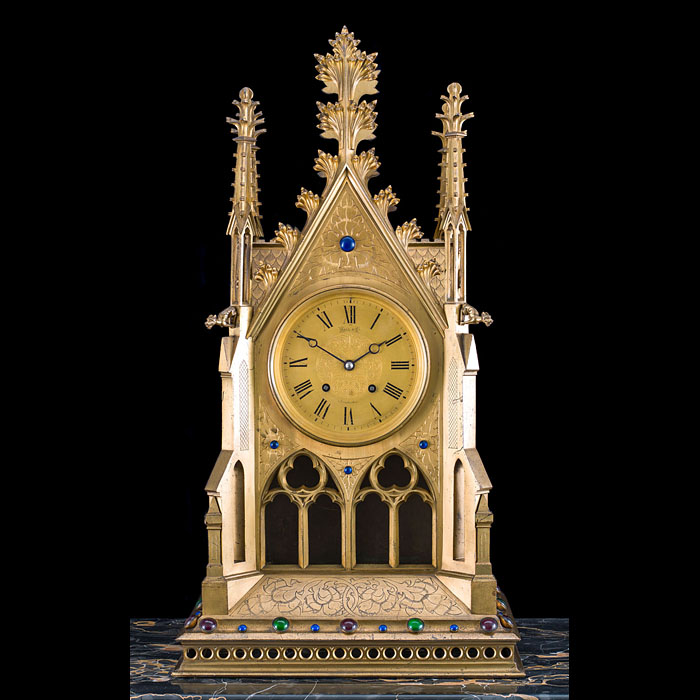 Sold
Sold
Stock: 14968
An impressive and large late 19th century French quarter chiming gilt brass Gothic
Revival bracket or mantel clock retailed by Hall & Company, Manchester. The case, with engraved floral decoration and applied coloured cabuchon jewel mounts, encloses a gilt 7" Roman dial with a finely scroll engraved centre and an eight day spring driven movement with anchor escapement chiming the quarters on a nest of two bells. The movement was made in Saint Nicolas d' Aliermont, by Pierre-Honoré-César Pons and then finished by the Parisian Clock maker, Louis Achille Brocot. French, circa 1870.
Link to: Antique clocks and clock garniture
|
width |
height |
depth |
|
16 7⁄8"
43 cms |
31 1⁄2"
80 cms |
12 3⁄16"
31 cms |
|
|
|
|
-
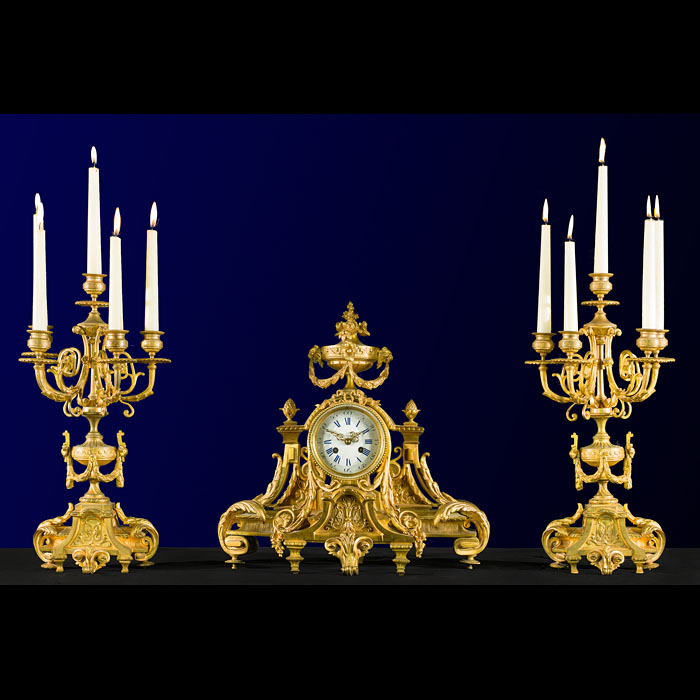 Sold
Sold
Stock: 14308
A gilt bronze highly elaborate, twin train striking mantel clock garniture in the Rococo style embellished throughout with acanthus scrolls and swags, urns, acorn finials and applied leaf detail echoed on the twin five branch candelabra.
The enamel clock face has fine cobalt blue Roman hours and black Arabic minutes with elaborate pierced
and engraved gilt hands. Movement by Bonnard, Dijon.
French mid 19th century.
Link to: Antique clocks and clock garniture
|
Width |
Height |
Depth |
| Clock |
18 1⁄8"
46 cms |
18 1⁄4"
46.5 cms |
4 7⁄8"
12.5 cms |
| Candelabras |
10 3⁄8"
26.5 cms |
19 11⁄16"
50 cms |
|
-
Stock: 13921
A fine French Siena Marble and Ormolu striking mantel clock garniture.
The gilt brass and enamel face with Arabic numerals & blued steel hands,
bears the inscription "A La Renaissance, 47-49 Bo St Martin Paris".
It is surmounted by a gilt bronze eagle wrestling a serpent with garlands
of flowers tumbling down either side to the brass mounted plinth.
The turned marble urns, set on square plinths, have gilt bronze handles
linked by swags of ormolu flowers.
This clock has its original fine quality eight day movement which
is in good working order.
French mid 19th Century.
Link to: Antique clocks and clock garniture
|
Width |
Height |
Depth |
| Clock |
21 1⁄8"
53.5 cms |
21 1⁄4"
54 cms |
7 7⁄8"
20 cms |
| Urns |
6 1⁄2"
16.5 cms |
10"
25.5 cms |
|
Listed Price: £6,300 (+VAT where applicable)
More info?

-
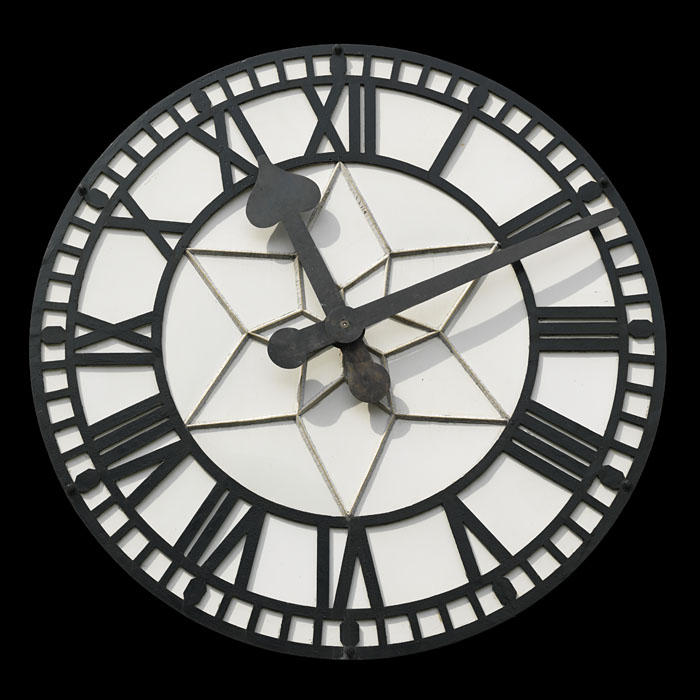
Stock: 9376
ROYAL ASCOT RACECOURSE CLOCKTOWER CHAPTER RINGS.
One of three original massive cast iron Chapter Rings from the 19th century Clock Tower at the Ascot Racecourse. When this Tower was demolished in the 1960s the chapter rings were transferred to the new one, see black and white image below. This Tower was itself replaced in 2004 when the 'New Grandstand' was built.
We fully restored them and on 1st August 2007 one was swung into position over the heads of 'Sophisticated South Shoreditchers' by an Italian Fossi Gru mobile crane and was set onto the steel box section cradle erected on the remnants of the wall of the 19th century tenements which once occupied the site of our present courtyard.
It is now a working clock, is illuminated at night and has become a local landmark.
One is now sold. The other remaining chapter ring is SNo 9377.
English late 19th century.
OLD ROYAL ASCOT
During June each year it seems the whole of the horse racing world's attention is focused on Royal Ascot near Windsor Castle and on the famous race meeting that is held there and where each year there is the inevitable parade of fashion. Royal Ascot was founded by Queen Anne in the 18th century and the first meeting took place on Saturday 11th August 1711. Her Majesty’s Plate worth 100 guineas was the inaugural event and was open to any horse, mare or gelding over the age of six. Each horse was required to carry a weight of 12 stone and seven runners took part. In 1760, when George II came to the throne, the once humble Royal Ascot became the second most popular race in all of England. A Grand Stand was built and from there spectators enjoyed panoramic views of the racecourse and its surroundings.
While the original wooden buildings have now been replaced it was and is the focal point of the course spanning a quarter of a mile. It's most prominent feature was the Clock Tower and it was under this Tower that Eliza Doolittle in the film "My Fair Lady" was heard to shout encouragement to her favoured steed " Dover" .
Link to: Antique clocks and clock garniture
Listed Price: £25,000 (+VAT where applicable)
More info?

Antique clocks not only showcase timeless elegance but also quality craftsmanship. They come in many forms, from the imposing and grandest of longcase clocks, to the exquisite beauty of a carriage clock. They can, therefore, find a place in almost any interior, and the comforting sound of their ticking and striking becomes the heartbeat of a home.
Antique mantel clocks were made to sit above a fireplace, they command attention in one of the post prominent positions in the home. For this reason, they are often very ornamental, using fine woods and metals that exude quality.
An antique clock garniture makes even more of a statement, as it comprises not only an antique mantel clock but also a pair of candelabra or urns, intended to sit either side of the clock. This became very popular in the 19th century when the mantelpiece was often displayed with collectible porcelain and objets d’art. Today, a clock garniture can either be displayed together on a mantelpiece or a table, or even separated, so the candelabra might be used on a dining table whilst the clock remains in place.
Antique French clocks are often accompanied by a garniture and are made from gilt bronze. Their movements exude quality and are often finer than their English counterparts.
The longcase clock is most domineering of all, standing taller than the inhabitants of the home and commanding attention with its authoritative ticking and striking. These large, magnificent clocks were made in many different woods, and some are even lacquered. Chinoiserie longcase clocks are delicately decorated with Chinese inspired designs, and emerged in the 18th century, when there was a huge surge in interest for East Asian artworks.
To be an antique clock dealer, understanding the workings of antique clocks, and their sometimes-temperamental nature, is important. Here at Westland London, we have a dedicated restoration department with experience in all areas of clock restoration.
An antique clock face is without doubt a more evocative sight than the bright lights of its digital successor, and we hope our selection of antique clocks will inspire you to have one in your home.